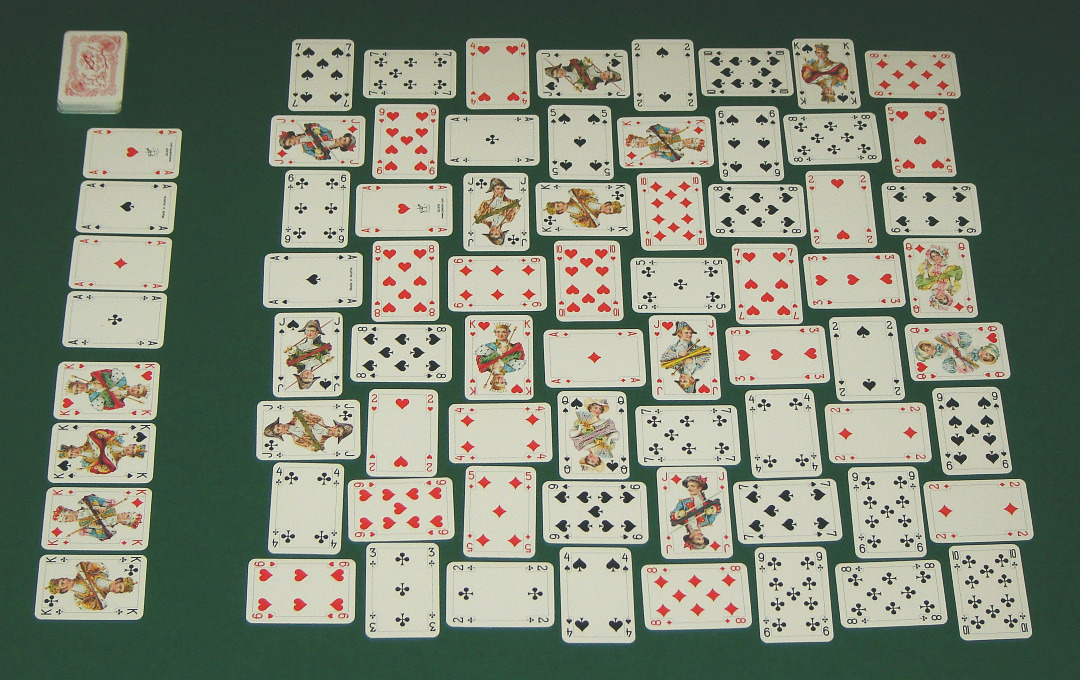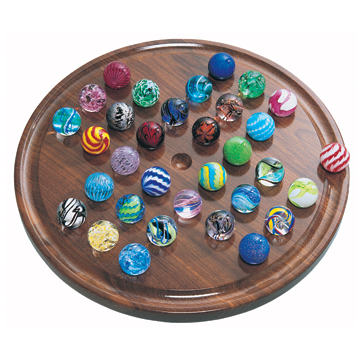|
Beetle (solitaire)
{{no footnotes, date=November 2013 Beetle is a difficult patience or solitaire card game using two decks of playing cards. The game is similar to Spider, except the Tableau cards are faced up. The object of the game is to group all of the cards into sets of 13 in suit. Rules Beetle has ten tableau stacks. Six of these contain four cards, and the other four consist of five cards. The deck is present towards the bottom left. File:Beetle Layout.jpg, Beetle Layout Group all of the cards into sets of 13 building down from King to Ace in suit (e.g. K♠, Q♠, J♠, 10♠...). The Tableau Stacks can be built down regardless of suit, but ordered groups can only be moved if they share the same suit (e.g. If there is , 3♣, 2♣ only the 3♣ & 2♣ can be moved as a group). Once a complete set of suited cards from King to Ace have been built, it will be removed from the Tableau. An empty space can be filled with any card or stack. When the gameplay comes to a standstill, clic ... [...More Info...] [...Related Items...] OR: [Wikipedia] [Google] [Baidu] |
Patience (game)
Patience (Europe), card solitaire or solitaire (US/Canada), is a genre of card games whose common feature is that the aim is to arrange the cards in some systematic order or, in a few cases, to pair them off in order to discard them. Most are intended for play by a single player, but there are also "excellent games of patience for two or more players". Name 'Patience' is the earliest recorded name for this type of card game in both British and American sources. The word is French in origin, these games being "regarded as an exercise in patience." Although the name solitaire became common in North America for this type of game during the 20th century, British games scholar David Parlett notes that there are good reasons for preferring the name 'patience'. Firstly, a patience is a card game, whereas a solitaire is any one-player game, including those played with dominoes or peg and board games. Secondly, any game of patience may be played competitively by two or more players. Am ... [...More Info...] [...Related Items...] OR: [Wikipedia] [Google] [Baidu] |
Solitaire
Solitaire is any tabletop game which one can play by oneself, usually with cards, but also with dominoes. The term "solitaire" is also used for single-player games of concentration and skill using a set layout tiles, pegs or stones. These games include peg solitaire and mahjong solitaire. The game is most often played by one person, but can incorporate others. History The origins of Card Solitaire or Patience are unclear, but the earliest records appear in the late 1700s across northern Europe and Scandinavia. The term ''Patiencespiel'' appears in ''Das neue Königliche L’Hombre-Spiel'', a German book published in 1788. Books were also reported to appear in Sweden and Russia in the early 1800s. There are additional references to Patience in French literature. In the United States, the first card solitaire book, ''Patience: A series of thirty games with cards'', was published by Ednah Cheney in 1870. The most popular card solitaire is Klondike, which was called Microsoft So ... [...More Info...] [...Related Items...] OR: [Wikipedia] [Google] [Baidu] |
Card Game
A card game is any game using playing cards as the primary device with which the game is played, be they traditional or game-specific. Countless card games exist, including families of related games (such as poker). A small number of card games played with traditional decks have formally standardized rules with international tournaments being held, but most are folk games whose rules vary by region, culture, and person. Traditional card games are played with a ''deck'' or ''pack'' of playing cards which are identical in size and shape. Each card has two sides, the ''face'' and the ''back''. Normally the backs of the cards are indistinguishable. The faces of the cards may all be unique, or there can be duplicates. The composition of a deck is known to each player. In some cases several decks are shuffled together to form a single ''pack'' or ''shoe''. Modern card games usually have bespoke decks, often with a vast amount of cards, and can include number or action cards. This ... [...More Info...] [...Related Items...] OR: [Wikipedia] [Google] [Baidu] |
Spider (solitaire)
Spider is a type of patience game, and is one of the more popular two-deck solitaire games. The game originates in 1949, and its name comes from a spider's eight legs, referencing the eight foundation piles that must be filled to win the game. Rules The main purpose of the game is to remove all cards from the table, assembling them in the tableau before removing them. Initially, 54 cards are dealt to the tableau in ten piles, face down except for the top cards. The tableau piles build down by rank, and in-suit sequences can be moved together. The 50 remaining cards can be dealt to the tableau ten at a time when none of the piles are empty. A typical Spider layout requires the use of two decks. The Tableau consists of 10 stacks, with 6 cards in the first 4 stacks, with the 6th card face up, and 5 cards in the remaining 6 stacks, with the 5th card face up. Each time the stock is used it deals out one card to each stack. Variants Given its popularity, numerous Spider variants ... [...More Info...] [...Related Items...] OR: [Wikipedia] [Google] [Baidu] |
Glossary Of Solitaire Terms
Games of patience, or (card) solitaires as they are usually called in North America, have their own 'language' of specialised terms such as "building down", "packing", "foundations", "talon" and "tableau". Once learnt they are helpful in describing, succinctly and accurately, how the games are played. Patience games are usually for a single player, although a small number have been designed for two and, in rare cases, three or even four players. They are games of skill or chance or a combination of the two. There are three classes of patience grouped by object. The most frequent object is to arrange the cards either in ascending sequence (e.g. from Ace to King) or descending sequence. Occasionally both forms of sequence are aimed at in the same game. The card forming the starting point of the required sequence is known as the foundation card and the sequence or family is said to be 'built up' on such card. In some cases foundation cards are picked out and placed in position ... [...More Info...] [...Related Items...] OR: [Wikipedia] [Google] [Baidu] |
List Of Patience Games
This is a list of patiences, which are card games that are also referred to as solitaires or as card solitaire. This list is not intended to be exhaustive, but only includes games that have met the usual Wikipedia requirements (e.g. notability). Additions should only be made if there is an existing entry on Wikipedia that they can be linked to. To avoid duplicate pages being created, alternative titles and the names of variants are listed separately (except titles that include little more than the name of the parent game). Games of the patience genre played by more than one player are marked with a plus (+) sign. A * Accordion * Aces and Kings * Aces Square * Aces Up * Acme * Addiction * Agnes * Alaska * Algerian * Alhambra * Amazons * American Toad * Apophis * Appreciate * Acquaintance * Archway * Auld Lang Syne * Australian Patience B * Babette * Backbone * Baker's Dozen * Baker's Game * Baroness * Batsford * Beetle * Beleaguered Castle * Belvedere * Be ... [...More Info...] [...Related Items...] OR: [Wikipedia] [Google] [Baidu] |
Glossary Of Solitaire
Games of patience, or (card) solitaires as they are usually called in North America, have their own 'language' of specialised terms such as "building down", "packing", "foundations", "talon" and "tableau". Once learnt they are helpful in describing, succinctly and accurately, how the games are played. Patience games are usually for a single player, although a small number have been designed for two and, in rare cases, three or even four players. They are games of skill or chance or a combination of the two. There are three classes of patience grouped by object. The most frequent object is to arrange the cards either in ascending sequence (e.g. from Ace to King) or descending sequence. Occasionally both forms of sequence are aimed at in the same game. The card forming the starting point of the required sequence is known as the foundation card and the sequence or family is said to be 'built up' on such card. In some cases foundation cards are picked out and placed in position ... [...More Info...] [...Related Items...] OR: [Wikipedia] [Google] [Baidu] |
Double-deck Patience Card Games
A double-decker is a vehicle that has two levels for passengers or cargo, one deck above the other. Such vehicles include: * Aerial tramway * Bilevel rail car a rail passenger vehicle consisting of 2 levels * Bombardier BiLevel Coach * Bombardier MultiLevel Coach * Dome car * Double-deck aircraft * Double-deck elevator * Double-decker bus * Double-decker tram * Superliner (railcar) * Autorack (US) or car transporter (UK), a railway vehicle for transporting cars or other road vehicles * Car carrier trailer or auto carrier, a road trailer for transporting cars or other road vehicles * Two-decker is a sailing ship with 2 decks armed with cannon. A double-decker may also refer to: * Double Decker (chocolate bar) * Double-decker sandwich, such as a club sandwich or Dagwood sandwich, with two layers of meat and condiments sandwiched between three pieces of bread * A multi-level roadway such as those found in Chicago * A multi-level bridge Multilevel or multi-level may refer to: * A ... [...More Info...] [...Related Items...] OR: [Wikipedia] [Google] [Baidu] |





